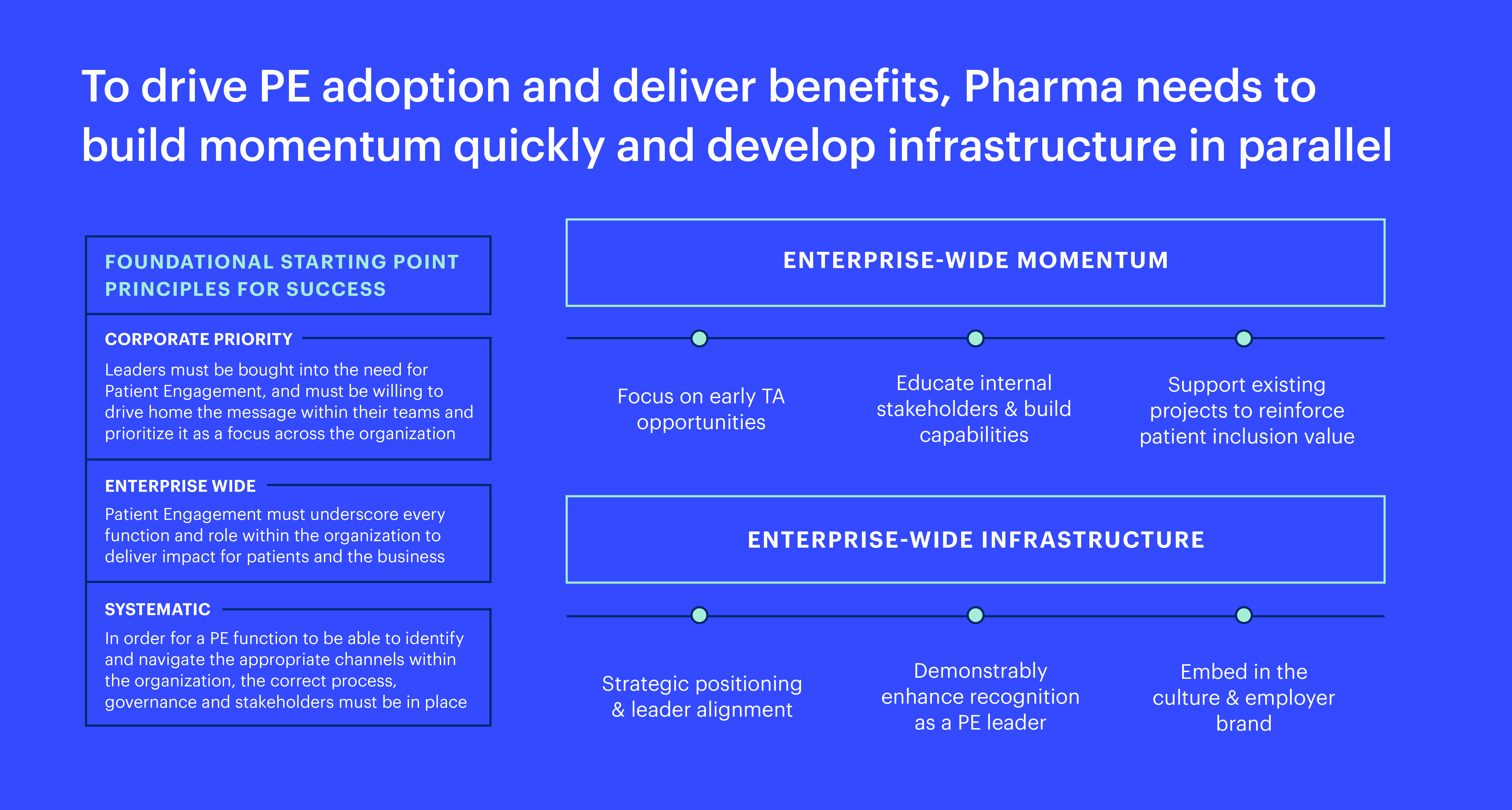BLOG
The Keys to Improving Patient Engagement in Pharma
The notion of patient engagement has been taking shape for over 30 years. Here are 10 tips to accelerate and embed patient engagement systematically in your organization.
The notion of patient engagement has been taking shape for over 30 years. Going beyond patient advocacy, patient engagement is the active involvement of patients in processes and decision-making in their care experience, across the entirety of the development lifecycle and beyond.
Patient engagement works to address health disparities and inequity more systematically by including and elevating diverse patient voices across the key touchpoints of drug development, ultimately raising the standard of care all patients receive and the outcomes they experience. It’s about going beyond clinical outcomes and driving a more holistic understanding of patients and the treatment effect across their preferences, social phenotypes and circumstances – socioeconomic or otherwise. Ultimately, the goal is to create medicines, treatments and experiences with (not for) patients.
And we’ve seen the business and clinical results at key points across the development cycle.

So Why Haven’t Pharmaceutical Companies Cracked It?
Pharma is the only industry that has not fully embraced the end user in its product development. The practice of understanding patients and applying that understanding systematically to treatment development is complex and difficult.
There are several barriers to successfully engaging patients in pharma:
- Historic Disregard of the Patient – The industry has historically been wired to disregard the perspectives and needs of patients outside of the clinical outcomes related to therapies of interest. Practitioners can often be resistant to centering on patients, with a typically paternalistic relationship with patients, coupled with a lack of time and capacity to actively involve patients in their care.
- Regulations and Resources – The regulatory requirements, time and investment required to engage with patients mean it often doesn’t happen. Or at best, it happens sporadically.
- Corporate Culture – Fragmented and siloed corporate structures and cultures result in ad hoc and unsustainable attempts at patient engagement. Not to mention, they are often not built into the drug development lifecycle.
- Limited Pharma-Patient Interactions – Patients have limited capacity and agency to engage with pharma, leading to difficulties in diverse and representative patient groups.
- Lack of Faith as a Strategic Priority – Due to the delayed ROI associated with patient engagement, pharma struggles with prioritizing patient engagement as a sustained and systematic business imperative.
The only way to initiate and scale patient engagement sustainably is to take a systematic approach across the entire organization and at key moments throughout the drug development lifecycle.
External Pressures for Patient Engagement are Mounting
All of that said, the lack of impetus is changing. Patient engagement is no longer a nice to have, with a range of forces driving an increased focus on patient engagement. Industry leader, Roche, is in the process of training 10,000+ employees in patient engagement. The most important medicines regulators in the world, the FDA (Food and Drug Administration) and EMA (European Medicines Agency) are strongly invested in expanding Patient-Focussed Drug Development (PFDD). In 2016, the FDA codified patient engagement as a key pillar of its mission, formally requiring records of Patient Perspectives in drug review under PDUFA VI. It will become increasingly difficult and slow to get new indications approved and paid for without showing patient engagement throughout the development process and treatment regime design. The global COVID-19 pandemic has also seen familiarity, scrutiny and pressure on pharma corporate brands as their reputations increased hugely, presenting a timely and important opportunity to build trust and understanding between pharma and patients.
The Solution? Systematically Embed Patient Engagement into Your Culture and Operating Model
Through the learnings shared by different businesses and patient engagement leaders, it has become evident that no existing business function can fully own patient engagement. An overarching function, or center of excellence, must focus on shifting mindsets of each therapeutic area and motivating change while permeating tools, training, new ways of working, processes and systems through all cross-functional aspects of the organization to deliver impact for patients and ensure patient engagement practices are adopted cohesively.
Leaders must be bought into the need for patient engagement and must be willing to drive home the message within their teams and prioritize it as a focus across the organization. For a patient engagement function to be able to identify and navigate the appropriate channels within the organization, the correct process, governance and stakeholders must be in place. This requires organizational, operating model and cultural adaptations to bring an enterprise-wide and systematic approach to patient engagement. Getting it right brings not only better results but renewed purpose and inspiration to teams across the business.
10 Tips to Embed Patient Engagement (PE) Systematically in Your Organization
From our experience globally we have distilled the key areas of focus that will help you build and embed a systematic approach to Patient Engagement across your organization
Set Up Strategically
- Embed patient engagement holistically, X-FN and enterprise-wide approach
- Clearly articulate the value of patient engagement – and link it to the corporate and therapeutic strategies
- Ensure the patient engagement function sits strategically in the organization and is clearly distinguishable from other patient-facing functions, acting as a key enabler for other functions
Initiate Meaningful Work
- Create a comprehensive patient experience blueprint that drives equitable access to care and an improved experience
- Start by piloting patient engagement initiatives and tactics in the “moments that matter” across the lifecycle
- Develop a patient insights function to understand patient experiences and improve outcomes
Disseminate and Scale Rapidly
- Build patient engagement infrastructure quickly by codifying best practices into repeatable processes
- Fill gaps in understanding with bespoke learning and development programs
- Maintain momentum by creating visible platforms to articulate the importance of patient engagement
- Focus on the value of patient engagement to society – the “S” in ESG (Environmental, Social, Governance)
Making Patient Engagement Happen

To become systematic in your organization, patient engagement needs to be driven by enterprise-wide momentum while being bolstered simultaneously with enterprise-wide infrastructure. Why? Proving the ROI of patient engagement is still challenging for most organizations. As a result, the patient engagement function needs to develop a strong and robust proof of concept across drug development and commercial processes. This means partnering and collaborating across the business to make sure everyone is clear on what ‘including the patient’ looks like in their role. This will reconnect employees with the organizational purpose, which in turn attracts top talent, galvanizing them to build enterprise momentum around the value of patient engagement.
At the same time, for this to be sustainable, we need to ensure a systematic approach so pharma can realize the full ROI of patient engagement – building the right infrastructure to make this happen. You need momentum to be able to build the infrastructure. These two things can’t be done sequentially, they need to be done in tandem.
FINAL THOUGHTS
The good news is that it’s easy to get started. Patient engagement is inherently motivating to your people and every pharma organization has teams with an immediate need for support.
To figure out how to accelerate the momentum of your patient engagement strategy and embed it across your organization, Prophet conducts a 2-hour workshop that helps clients define and articulate their challenges and where they need to focus efforts based on our top 10 insights outlined above. Get in touch with our Organization & Culture experts at Prophet to learn more.

